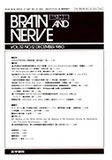Japanese
English
- 有料閲覧
- Abstract 文献概要
- 1ページ目 Look Inside
1.はじめに
一次体性感覚野が,てんかん性棘波の焦点である場合,体性感覚誘発電位(SEPと略す)がさまざまに変化することが知られているが,動物の種類や棘波誘発物質の違いなどにより変化の様相が各々異なり一定した所見を得ていない7,11)。Ratを用いたペニシリン焦点モデルにおいてHolubár10)は,焦点におけるSEPの陰性部分が次第に拡大し,感覚入力により誘発された陰性棘波へと発展してゆくことを特徴として記載した。一方,棘波自体は延髄および視床に存在するsensory relay nu—cleusにおける感覚入力の伝達を抑制することが知られている1,5,9,17,18)。これらの事実は,SEPの振幅の変化が,感覚野焦点の感覚入力に対する過剰反応と,棘波自体の入力に対する抑制効果の相互作用により生ずることを示している。本研究の目的は,以上のごとき条件の下で,ratの一次体性感覚野が棘波焦点である場合,SEPの変動を脳波上の棘波活動と関連づけて分析し,さらに微小電極を用いた神経細胞発射記録の観察により,より詳細にSEPの各componentの変化を調べることである。
Acute experiments were performed in 59 Sprague-Dowley rats. After light Nembutal anesthesia, the animal was immobilized and ventilated. The pri-mary sensory cortex (Dowson 1966, Angel et al. 1973) was exposed and focal epileptic activity was induced with Penicillin-G Natrium.
Conventional EEG, SEP and unitary discharge were monitored as experimental parameters. Re-covery cycles of SEPs following cortical spikes were observed also from the cuneate nucleus, the ventral nucleus of the thalamus and the primary cortex.
On the EEG, epileptic spike activities were classified as follows:
Stage I ……appearance of small sporadic spikes
Stage II…… regular large spikes at frequency of 0.1 to 0.9c/s
Stage III…… the frequency of the spikes more than 1c/s.
After application of Penicillin-G Natrium, spike activity on the EEG developed gradually from stage I to III.
The components of SEP were termed arbitarily P1, N1, P2 and N2 in order of the latencies (P represent positivity and N negativity). At stage I and II, the amplitude of P2 and N2 increased dramatically and the latter corresponded to induced spike on the EEG. On the other hand, at stage III, the amplitude of these components became smaller, especially the negativity of SEP, as a result, positivities of SEP dominated. P1 and Ni remained relatively unchanged from stage I to III. Two sorts of unitary responses to somatosensory stimuli were demonstrated i.e. the one with shorter latency and the other with longer latency (SLR and LLR respectively). The LLR increased in duration andfrequency simultaneously with the amplitude en-largement of P2 and N2, and occasional recurrent discharges continued as long as 100 msec after the stimulus. On the other hand, SLR remained rela-tively unchanged. The recovery cycles of SEP disclosed that the cuneate response recovered first, then thalamic and P1/N1 components, and lastly the recovery of P2/N2 occurred. The relative re-fractory period observed in the recovery cycle of cortical SEP continued for about 300 msec at stage II.
Angel and Lemon (1974) observed two kinds of unitary respones to somatosensory stimulus recorded over the primary sensory cortex of normal rats. They reported that the response with longer latency was due to the discharges of the pyramidal cells. LLR cells observed in our experiment are assumed to be those of loner latency described by Angle and Lemon, and our results indicate that abnormal responses of P2/N2 to stimulus are chiefly due to the discharges of the pyramidal cells. Consistent with our findings, Petsche et al. (1971) verified that cortical spikes induced with Penicillin on the rabbit cortex corresponded to the abnormal activity of pyramidal cells. The delayed recovery of P2/N2 components of cortical SEP following spikes ob-served is considered to be due to epileptic change of pyramidal cells. With increment of spiking frequency, the probability that stimuli fall into the refractory period increases and as a result, the amplitude of SEP became smaller at stage III. The duration of refractory period which lasts for about 300 msec following a cortical spike may also explain why spontaneous interictal spiking do not exceed the rate of 3.0-3.5cps (Gastaut and Hunter 1950).

Copyright © 1980, Igaku-Shoin Ltd. All rights reserved.


